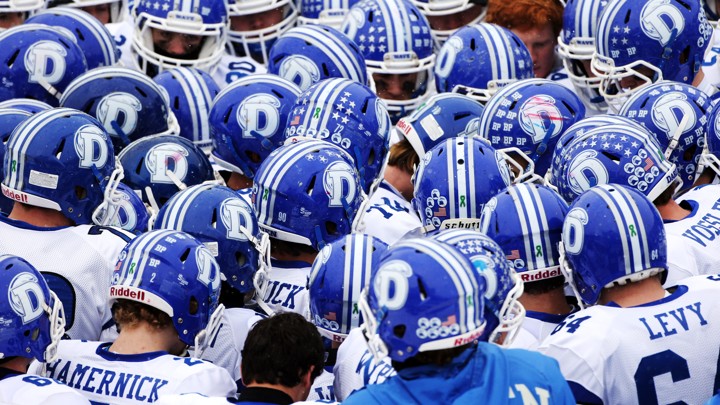
If you want to understand how income inequality and opportunity-hoarding by the rich can combine in toxic ways to hurt the less fortunate, you could look in all the usual places—elite colleges, housing policy, internships.
Or you could look at high-school sports.
In the 2018–19 school year, the number of kids participating in high-school sports declined for the first time in three decades. At least, that was the headline; the reality was even worse. Thirty years ago, the high-school population itself was shrinking, due to a short-term falloff in births after the Baby Boom. This past school year is the only period on record when high-school sports participation declined even as school attendance increased.
“It doesn’t surprise me, but it definitely concerns me,” Tom Farrey, the executive director of the Aspen Institute’s Sports and Society Program, told me. “Evidence on the benefits of youth sports has grown by leaps and bounds over the past decade. Kids who are physically active are one-tenth as likely to be obese, less likely to have chronic disease, and more likely to stay in school.”
The most obvious reason for the decline of high-school sports is that football, the Friday-night-lit mainstay of the high-school experience, is withering on the vine, likely due to fears about injuries and head trauma. The number of high-school boys playing the sport fell for the fifth straight year in 2018–19, and fewer male high schoolers now play football than at any other time this century. Many schools cannot field a full team and have resorted to a six-on-six version, according to the National Federation of State High School Associations (NFHS). America’s most popular sport on television could be close to a full-blown crisis.
But it’s not just football. Basketball, baseball, golf, and lacrosse are all losing players too. The number of girls playing high-school basketball has fallen to its lowest level since the early 1990s. Head injuries can’t explain all that. Neither can school funding or the number of high-school teams, which are steady, according to the NFHS. Something else is going on.
Daniel Markovits: How life became an endless, terrible competition
So is it screens?
Smartphones conveniently take the blame for just about every other societal ill, from rising anxiety to declining sex. But Farrey assured me that screen culture is not the culprit here. What’s telling, he said, is that the children of high-income parents are playing as much as ever. Kids from homes earning more than $100,000 are now twice as likely to play a team sport at least once a day as kids from families earning less than $25,000.
The deeper story is that the weed of American-style meritocracy is strangling the roots of youth sports. As parents have recognized that athletic success can burnish college applications, sports have come to resemble just another pre-professional program, with rising costs, hyper-specialization, and massive opportunity-hoarding among the privileged.
Before kids enter high school, they tend to participate in youth sports leagues, which have become one big pay-to-play machine. It’s now common for high-income parents to pull their kids out of the local soccer or baseball leagues and write thousand-dollar checks to join super-teams that travel to play similar kids several counties away. As I wrote last year, it’s not a crime for parents to spend money on their children. But as travel teams hoard talented (and, typically, high-income) kids, they leave behind desiccated local leagues with fewer resources and fewer players. As a result, many low-income children lose the sports habit (or never gain it to begin with), and simply stop playing altogether by the time they get to high school.
Another crucial factor is the rise in sports specialization. Once again, it might seem harmless that ambitious parents and coaches want talented kids to pick a sport and focus on it. But the frenzy around early specialization might be misplaced. A 2015 paper from Harvard concluded that specialization—defined as at least one year of intensive training in a single sport that requires quitting other activities—increased risks of “injury and burnout.” In July, ESPN published a two-part story on specialization in basketball and its correlation with injuries and emotional exhaustion. One coach likened the overwork of young athletes to “an epidemic.”
What’s more, it’s simple math that specialization means fewer kids per high-school sports team. A teenager who plays three sports counts as three distinct participants in the NFHS data. So the decline in participants partly reflects the fact that students who, 20 years ago, played football in the fall, basketball in the winter, and baseball in the spring are now just focusing entirely on, say, basketball.
Derek Thompson: Would you rather a recession, or Trump?
Obsessive competition in high-school athletics is inseparable from the gargantuan role that sports plays in college admissions.
“Athletic recruiting is the biggest form of affirmative action in American higher education,” says Philip Smith, a former dean of admissions at Williams College, has said. (About 30 percent of Williams students are recruited athletes.) In the 1990s, Division I and Division II colleges annually distributed less than $300 million in student-athlete scholarships. Today that figure is more than $3 billion.
You might think most of that scholarship money is going to help kids from poor families who couldn’t otherwise afford college. That’s not the case. In 2010, just 28 percent of Division I basketball players were first-generation college students, meaning they likely came from low-income families. Five years later, that figure has fallen by nine percentage points. Today, fewer than one in seven students receiving athletic scholarships across all Division I sports come from families in which neither parent went to college. Farrey calls this the slow-motion “gentrification” of college sports.
This process starts in youth and high-school sports. Both historically served as a pipeline to flagship universities for low-income kids. But when they’re shut out from pricey travel leagues and the expensive coaching that early specialists receive, lower-income kids are denied not only the physical benefits of playing sports, but also the jackpot that is college recruitment and Division I and II scholarships.
Institutions that were meant to be opportunity-equalizers for the rich, poor, and everybody in between—community youth sports leagues, public high schools, the American college system—are being stealthily hijacked to serve the primary goal of so many high-income parents, which is to replicate their advantages in their children’s generation.
[“source=theatlantic”]







